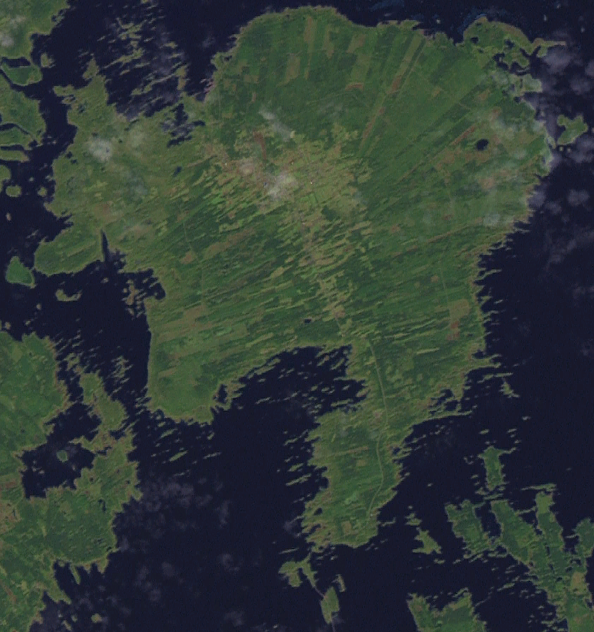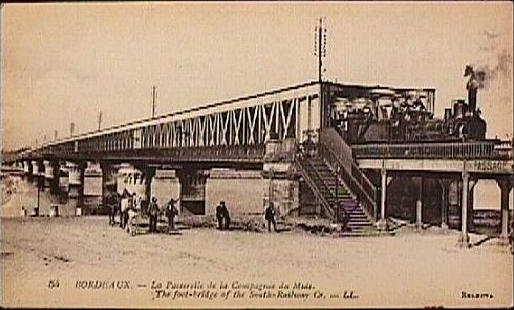|
Kvarken Archipelago
Kvarken ( sv, Kvarken, Norra Kvarken (as opposed to South Kvarken); ) is the narrow region of the Gulf of Bothnia separating the Bothnian Bay (the inner part of the gulf) from the Bothnian Sea. The distance from the Swedish mainland to the Finnish mainland is around , while the distance between the outermost islands is only . The water depth in the Kvarken region is only around . The region also has an unusual rate of land rising at almost a year. Several attempts to cross the strait swimming have been made, but cold water and currents have usually been insurmountable obstacles. The first successful crossing was carried out by Lennart Flygare, Pavio Grzelewski and Tore Klingberg, who on 24 July, 2018, swam from Valassaaret (Valsörarna) on the Finnish side to Holmöarna in Sweden. It took them 12 hours 2 minutes to cross the strait. Kvarken Archipelago On the Finnish side of Kvarken, there is a large archipelago, the Kvarken Archipelago, which includes the large islands Re ... [...More Info...] [...Related Items...] OR: [Wikipedia] [Google] [Baidu] |
Björkö (Korsholm)
Björkö is an island in Korsholm municipality, Finland. It is situated in the Kvarken area of the Gulf of Bothnia. The chief settlement is called Björköby. In addition to the main island, the Björkö area includes 350 skerry, skerries and its total area is 72 km2. In 1973, the Björköby municipality merged to Korsholm. During the Swedish reign over Finland, the island was notable for being a post transport base in the archipelago on the Finnish side. Mail was ferried by the inhabitants of Björkö to the islands of Holmöarna, Sweden. They got reductions in taxes and exemption from military service for this (strategic) service. Ferry services to the regional capital Vaasa began in 1907 and in 1954, a causeway was built to the major island of the archipelago, Replot, which was connected to the mainland by a car ferry. In 1997, the Replot bridge finally connected also Björkö to the mainland by road. Finnish islands in the Baltic Korsholm Landforms of Ostroboth ... [...More Info...] [...Related Items...] OR: [Wikipedia] [Google] [Baidu] |
Sweden–Finland
Sweden–Finland ( fi, Ruotsi-Suomi; sv, Sverige-Finland) is a Finnish historiographical term referring to Sweden from the twelfth century to the Napoleonic Wars. In 1809, the realm was split after the Finnish War. The eastern half came to constitute the autonomous Grand Duchy of Finland, in personal union with Imperial Russia. The term was coined by Finnish historians during the 1920s, but since then there has been an effort to drop it from professional historiography due to its perceived inaccuracy.Jussila, Osmo: Suomen historian suuret myytit. WSOY, Helsinki 2007. However, it is often still used in everyday Finnish speech. Although the term has didactic merits, for instance when used in conjunction with the term Denmark–Norway, it is misleading because Finland was an integrated part of the realm since the twelfth century, whereas Denmark and Norway were two sovereign kingdoms, which were united by personal union in 1380, but remained separate states until the sixteenth c ... [...More Info...] [...Related Items...] OR: [Wikipedia] [Google] [Baidu] |
Malmö
Malmö (, ; da, Malmø ) is the largest city in the Swedish county (län) of Scania (Skåne). It is the third-largest city in Sweden, after Stockholm and Gothenburg, and the sixth-largest city in the Nordic region, with a municipal population of 350,647 in 2021. The Malmö Metropolitan Region is home to over 700,000 people, and the Øresund Region, which includes Malmö and Copenhagen, is home to 4 million people. Malmö was one of the earliest and most industrialised towns in Scandinavia, but it struggled to adapt to post-industrialism. Since the 2000 completion of the Öresund Bridge, Malmö has undergone a major transformation, producing new architectural developments, supporting new biotech and IT companies, and attracting students through Malmö University and other higher education facilities. Over time, Malmö's demographics have changed and by the turn of the 2020s almost half the municipal population had a foreign background. The city contains many histori ... [...More Info...] [...Related Items...] OR: [Wikipedia] [Google] [Baidu] |
Copenhagen
Copenhagen ( or .; da, København ) is the capital and most populous city of Denmark, with a proper population of around 815.000 in the last quarter of 2022; and some 1.370,000 in the urban area; and the wider Copenhagen metropolitan area has 2,057,142 people. Copenhagen is on the islands of Zealand and Amager, separated from Malmö, Sweden, by the Øresund strait. The Øresund Bridge connects the two cities by rail and road. Originally a Viking fishing village established in the 10th century in the vicinity of what is now Gammel Strand, Copenhagen became the capital of Denmark in the early 15th century. Beginning in the 17th century, it consolidated its position as a regional centre of power with its institutions, defences, and armed forces. During the Renaissance the city served as the de facto capital of the Kalmar Union, being the seat of monarchy, governing the majority of the present day Nordic region in a personal union with Sweden and Norway ruled by the Danis ... [...More Info...] [...Related Items...] OR: [Wikipedia] [Google] [Baidu] |
Vaasa
Vaasa (; sv, Vasa, , Sweden ), in the years 1855–1917 as Nikolainkaupunki ( sv, Nikolajstad; literally meaning "city of Nicholas),Vaasa oli ennen Nikolainkaupunki ja Aurinkolahti Mustalahti – paikannimiä ei kuitenkaan pidä muuttaa heppoisin perustein – '''' (in Finnish) is a city on the west coast of . It received its charter in 1606, during the reign of [...More Info...] [...Related Items...] OR: [Wikipedia] [Google] [Baidu] |
Umeå
Umeå ( , , , locally ; South Westrobothnian: ;). fi, Uumaja; sju, Ubmeje; sma, Upmeje; se, Ubmi) is a city in northeast Sweden. It is the seat of Umeå Municipality and the capital of Västerbotten County. Situated on the Ume River, Umeå is the largest locality in Norrland and the thirteenth largest in Sweden, with a wider municipal population of 130,224 inhabitants in 2020. When Umeå University was established in 1965, growth accelerated, and the amount of housing has doubled in 30 years from 1980 to 2010. , Umeå was gaining around 1000 inhabitants per year and the municipality plans for having 200 000 inhabitants by 2050. The projection of municipality size in 2050 has, however, been questioned as an overestimation in an independent study. Umeå is a university town and centre of education, technical and medical research in northern Sweden. The two universities located in the city, Umeå University and one of the 3 main branches of SLU, host around 40,000 enrolled s ... [...More Info...] [...Related Items...] OR: [Wikipedia] [Google] [Baidu] |
Euro
The euro ( symbol: €; code: EUR) is the official currency of 19 out of the member states of the European Union (EU). This group of states is known as the eurozone or, officially, the euro area, and includes about 340 million citizens . The euro is divided into 100 cents. The currency is also used officially by the institutions of the European Union, by four European microstates that are not EU members, the British Overseas Territory of Akrotiri and Dhekelia, as well as unilaterally by Montenegro and Kosovo. Outside Europe, a number of special territories of EU members also use the euro as their currency. Additionally, over 200 million people worldwide use currencies pegged to the euro. As of 2013, the euro is the second-largest reserve currency as well as the second-most traded currency in the world after the United States dollar. , with more than €1.3 trillion in circulation, the euro has one of the highest combined values of banknotes and coins in c ... [...More Info...] [...Related Items...] OR: [Wikipedia] [Google] [Baidu] |
Eiffel Tower
The Eiffel Tower ( ; french: links=yes, tour Eiffel ) is a wrought-iron lattice tower on the Champ de Mars in Paris, France. It is named after the engineer Gustave Eiffel, whose company designed and built the tower. Locally nicknamed "''La dame de fer''" (French for "Iron Lady"), it was constructed from 1887 to 1889 as the centerpiece of the 1889 World's Fair. Although initially criticised by some of France's leading artists and intellectuals for its design, it has since become a global cultural icon of France and one of the most recognisable structures in the world. The Eiffel Tower is the most visited monument with an entrance fee in the world: 6.91 million people ascended it in 2015. It was designated a '' monument historique'' in 1964, and was named part of a UNESCO World Heritage Site ("Paris, Banks of the Seine") in 1991. The tower is tall, about the same height as an 81- building, and the tallest structure in Paris. Its base is square, measuring on each sid ... [...More Info...] [...Related Items...] OR: [Wikipedia] [Google] [Baidu] |
Gustave Eiffel
Alexandre Gustave Eiffel (born Bonickhausen dit Eiffel; ; ; 15 December 1832 – 27 December 1923) was a French civil engineer. A graduate of École Centrale des Arts et Manufactures, he made his name with various bridges for the French railway network, most famously the Garabit Viaduct. He is best known for the world-famous Eiffel Tower, designed by his company and built for the 1889 Universal Exposition in Paris, and his contribution to building the Statue of Liberty in New York. After his retirement from engineering, Eiffel focused on research into meteorology and aerodynamics, making significant contributions in both fields. Early life Alexandre Gustave Eiffel was born in France, in the Côte-d'Or, the first child of Catherine-Mélanie (née Moneuse) and Alexandre Bonickhausen dit Eiffel. He was a descendant of Marguerite Frédérique (née Lideriz) and Jean-René Bönickhausen and who had emigrated from the German town of Marmagen and settled in Paris at the beginning of ... [...More Info...] [...Related Items...] OR: [Wikipedia] [Google] [Baidu] |
World Heritage Site
A World Heritage Site is a landmark or area with legal protection by an international convention administered by the United Nations Educational, Scientific and Cultural Organization (UNESCO). World Heritage Sites are designated by UNESCO for having cultural, historical, scientific or other form of significance. The sites are judged to contain " cultural and natural heritage around the world considered to be of outstanding value to humanity". To be selected, a World Heritage Site must be a somehow unique landmark which is geographically and historically identifiable and has special cultural or physical significance. For example, World Heritage Sites might be ancient ruins or historical structures, buildings, cities, deserts, forests, islands, lakes, monuments, mountains, or wilderness areas. A World Heritage Site may signify a remarkable accomplishment of humanity, and serve as evidence of our intellectual history on the planet, or it might be a place of great natural beauty. A ... [...More Info...] [...Related Items...] OR: [Wikipedia] [Google] [Baidu] |
Moraine
A moraine is any accumulation of unconsolidated debris (regolith and rock), sometimes referred to as glacial till, that occurs in both currently and formerly glaciated regions, and that has been previously carried along by a glacier or ice sheet. It may consist of partly rounded particles ranging in size from boulders (in which case it is often referred to as boulder clay) down to gravel and sand, in a groundmass of finely-divided clayey material sometimes called glacial flour. Lateral moraines are those formed at the side of the ice flow, and terminal moraines were formed at the foot, marking the maximum advance of the glacier. Other types of moraine include ground moraines (till-covered areas forming sheets on flat or irregular topography) and medial moraines (moraines formed where two glaciers meet). Etymology The word ''moraine'' is borrowed from French , which in turn is derived from the Savoyard Italian ("mound of earth"). ''Morena'' in this case was derived from Provenà ... [...More Info...] [...Related Items...] OR: [Wikipedia] [Google] [Baidu] |





